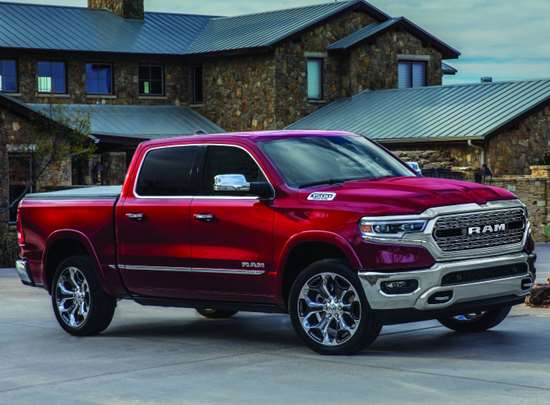Designing the 2019 Ram 1500
Ram Truck chief exterior designer Joe Dehner talks about how they’ve developed the all-new pickup. “We’ve been building trucks for over 100 years,” he says. “Best I could come up with is that this is our 15th-generation truck.”
#electronics #interior
There are a few truths about light-duty pickup trucks.
One, of course, is that they are the segment that pretty much pays the bills for almost everything else at an OEM. A person—and you’ll immediately know where they’re bias is toward—from FCA told me, “Around here some people say that Jeep keeps the lights on in Auburn Hills. Ram generates the electricity.” Yes, trucks are important like that.
Another is that given the market demand—the top-three selling vehicles in the U.S. in 2017 were the Ford F Series, the Chevrolet Silverado and the Ram, well, Ram—there is intense competition among the OEMs to eke out even greater sales in the market. (To give you some sense of how big this is, know that the sales of those three combined in 2017 are 1,983,351 vehicles. That number is greater than all of the Honda—car, truck, utility—or all of the Nissans—ditto—sold in 2017, which were 1,641,429 and 1,593,464, respectively, according to Autodata (motorintelligence.com).
So the development of a new truck is something that is taken more than seriously.
Joe Dehner is the chief exterior designer for Ram Truck. He says that the team has been working on the 2019 Ram 1500 for about four years. Another thing about trucks is that they tend to have longer cycles than cars do: the DS, the predecessor to the new vehicle (remarkably internally coded as the “DT”), was introduced in ’09 and had a midcycle refresh in 2013. If you think about it, launching a truck—or anything for that matter—in the U.S. market in late 2008 was not exactly a case of propitious timing, given the prevailing economic conditions. But Dehner says, in retrospect, that is somewhat indicative of the prevailing boldness of the brand. Of the ’09 he says, “We put the world on notice with the interior and the new exterior. A lot of sales success of the company were the sales of that truck.”
So for the new truck, Dehner says, they started working on the design about 3.5 years ago. “We thought that our truck was beginning to look old in the market, not only from a styling standpoint, but from a proportion standpoint.” He says that the original sketches—not surprisingly—featured big wheels and tires, a long wheelbase, short overhangs. Sort of the “Vehicle Design 101” primer.
But the proportions were the things that were most vexing. So they wanted to make a truck that was longer. Dehner recalls that the design team was “shooting for the moon,” looking for an increase on the order of five to six inches. It ended up at four.
“Then the question was: where do we put the additional length, in the cab or the bed?” He says that the designers thought that a bigger bed was the answer. “But our marketing friends said not, it is all about the cab: passenger priority. Yes, the bed is important, but the cab is more important.
“We were thinking about the truck in the traditional sense. And they were saying that trucks are used differently today—not just as a tool, but as a complement to a family’s lifestyle.”
They weren’t underestimating the importance of a truck to tradesmen and contractors. But they had to take into account that there is a significant amount of non-vocational use.
For some people the light-duty pickup has become the replacement for the four-door sedan: and it should be noted that the 2019 Ram 1500 is being built with four doors (Crew Cab and Quad Cab configurations). So the four inches of additional length were put into the passenger compartment. And who doesn’t want more space in a vehicle, whether you’re going to baseball practice or to a jobsite? (The interior volume of the Quad Cab is 63.9-ft3 in the front row and 53.3-ft3 in the back; the Crew Cab is 63.9-ft3 in the front and a massive 68.5-ft3 in the rear.)
Where design meets engineering
According to Dehner—who has done plenty of both in his tenure at FCA (even before it was FCA)—trucks are more difficult to design than cars. “It is because of the possible combinations and the overall modularity.” Different cabs, different boxes. Dehner says that he sees a trend toward what he calls “an extruded truck shape with the wheel openings pasted on.”
“Our truck actually has a Coke-bottle shape to it. I wouldn’t say that it is organic, but it is very sinuous and fluid.” It isn’t extruded from a giant die with a rectangular opening. “We had to make sure that the two different bed lengths”—5-ft, 7-in. and 6-ft, 4-in. boxes—“looked good.”
Dehner continues, “Our truck actually has a two-sweep in the body side.” He contrasts that with other trucks that are “dead flat in plan view.” Not only is this appealing aesthetically, but Dehner says that another reason for adding the sweep in the doors “was a request from engineering so as to get better stampings. When you do a flat body side, you can get stringers that come off the door handles. But by putting sweep in and by recessing the door handles into deeper pockets, we were able to eliminate that; it doesn’t become a quality issue.”
One of the things that Dehner is most pleased with is a 360-degree chrome DLO molding, which he says adds a distinctive touch of presence to the truck, as this is unique in the marketplace. He also points out that the bottom of that molding is part of a strong horizontal that goes across the truck, something that the previous generation truck lacks. The bed rail (which is increased in height by 35 mm for aero purposes) lines up with the bottom of the belt line and the top of the front fender. And to accentuate the horizontal sweep, there’s an A-line that arcs along the side, dropping off as it stretches back to the taillamp.
The Ram is available with a panoramic sunroof. This, Dehner says, required them to stiffen the windshield a bit and “didn’t hurt the design.”
While everyone talks about having faster windshields, Dehner says that they learned some surprising things about that when working both in the wind tunnel and with computational fluid dynamics. He says they tried one design with the base of the windshield pulled forward 10 inches and blended back in at the header. “No aero benefit whatsoever,” he says. They tried one at 12 inches. No benefit.
All in, thanks to the use of an active front air dam that deploys at 35 mph, as well as things like the higher bed height, a spoiler formed into the aluminum tailgate and other subtle modifications (e.g., a flush fuel-filler door: Dehner says that after they decided to get rid of the thumb tab they thought about molding in a small detent in order to provide a cue as to where to press to open it, but they decided against it so as to keep the surface clean), they’ve achieved a coefficient of drag (as measured on the 2019 Ram 1500 Quad Cab 4x2) of 0.357.
Absence and accentuation
Something that’s also visibly missing from the ’19 Ram is the cross-hair grille that has become something of a signature. In its place, they are using the word “RAM” instead (though Dehner says that if you look at the front of the Big Horn model “there are vestiges of the cross-hair hiding there,” something about nostrils at 3 o’clock and 9 o’clock and a ditch at 12 o’clock running down the middle of the hood and a subtle recess within the grille texture, but this is all like trying to crack the DaVinci Code).
“We own the territory of the big, round exhaust tips,” Dehner says, and they’ve not only retained the ownership, but have actually capitalized on it, increasing the diameter from 4 inches to 4.5. They increased the number of wheel lugs to six, which meant that they had to design all-new wheels, which they did: 15 of them.
A word about what Ryan Nagode, chief interior designer, and his team did for the inside of the 2019 Ram, which is arguably, across all of the six trims, a remarkable achievement and execution.
Although Nagode says that they worked very hard at “fine tuning” the interior—using soft-touch materials, deploying real materials (e.g., the Limited, top-of-the-line truck, features real leather, open-pore wood, stainless steel speaker grilles), integrating a 12-inch infotainment screen into the instrument panel (not visually sticking it on, as though someone took a tablet and a roll of Velcro and made the attachment, not integration as is executed here), addressing the fonts on the gauges so they’re appropriate to the model—he also says that when considering those six different trims, they were guided by six different hammers.
Yes, this is a truck. Sometimes sumptuous. Always hard-working.
RELATED CONTENT
-
Mustang Changes for 2018
On Tuesday Ford unveiled—using the social media channels of actor Dwayne Johnson (this has got to unnerve some of the auto buff book editors)—the 2018 Mustang, which has undergone some modifications: under the hood (the 3.7-liter V6 is giving way to a 2.3-liter EcoBoost four, and a 10-speed automatic is available), on the dash (a 12-inch, all-digital LCD screen is available for the dashboard), at the tires (12 wheel choices), on the chassis (MagneRide damper technology is being offered with the Mustang Performance Package), and on the exterior (three new paint colors). And while on the subject of the exterior, there are some notable changes—a lower, remodeled hood, repositioned hood vents, new upper and lower front grilles, LED front lights, revised LED taillamps, new rear bumper and fascia.
-
Can You Drive an EV in the Rain?
Although there is a veritable fleet of electric vehicles coming on the global market within the next few years, it seems that if the results of research in the United Kingdom track in any way with the rest of the world then the OEMs are in for a whole lot of electric vehicles sitting unsold in dealer lots.
-
All About the 2018 Honda Accord
The common wisdom seems to be that midsize cars have pretty much had it in the U.S. new car market.


.jpg;width=70;height=70;mode=crop)




